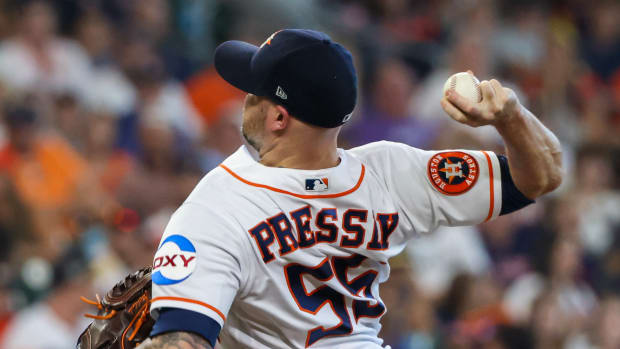Reds-Pirates Brawl Punctuates Exciting Blockbuster Trade
MLB’s deadline discourse runs on technical details—one rumor versus another, conflicting prospect evaluations, the question of which backup catcher for what fringe-y relief depth—but amid all this logistical set-up, under all this minutiae, there is one small source of humanity: Hug Watch.
Hug Watch is a reminder that players are people, not pieces, with a look at what this really means. A trade is only a notice that a player has to move to a new city and start in a new workplace and meet a bunch of new coworkers. So if he’s at work when he learns that he’s been traded, then, naturally, he’s going to hug his old coworkers goodbye. Hug Watch. It’s sweet, sometimes a little sad, almost childlike in its innocence. And, of course, it’s expected. We’ve come to understand that this is simply what a player does when he is traded during a game. He goes in for the hug.
Or—or—he runs into the middle of a wild brawl, gets ejected and makes a crazy trade that much crazier.
It’s unprecedented, perhaps ill-advised, and a hell of a lot of fun to watch. So, of course, it’s Yasiel Puig.
Even before any of this, Tuesday’s Reds-Indians-Padres three-way trade was set up as exciting stuff. First, it was a trade, any trade, in the final day of a deadline month that had thus far been rather slow. And, yes, it featured a marquee name like Trevor Bauer, a Cleveland team whose deadline strategy had previously been difficult to pin down and a San Diego team who had been a fixture in big trade rumors for weeks. But what was potentially the most surprising, most chaotic, most fun? That it included Cincinnati, who’d been only at the fringes of most deadline conversation, who’d come out of nowhere, who’d hardly seemed like a likely choice to land someone like Bauer. It’s a bold move—one made more with an eye toward next year, rather than this year, as the pitcher has an additional year of team control, but immediately splashy nonetheless.
So perhaps you saw this news breaking, and you wanted to tune into the last few innings of Cincinnati’s game against Pittsburgh. After all, it may not have been official, but reports were pouring in from all sides, and Puig was still on the field. Hug Watch? No. Puig still on the field… somehow still on the field… and then jumping into the heart of a bench-clearing brawl.
Of course, baseball generally isn’t proud of these kind of things—it’s not exactly what you might call responsible behavior, it’s an injury risk, it’s impractical and sometimes juvenile and often rather silly. Logically, that’s all clear. But none of that stops these brawls from being wildly entertaining, or, at the least, very difficult to turn away from. Such is the allure of “FIGHT!”, even if there’s typically very little actual fighting involved in a baseball brawl. And Tuesday’s was right at the peak of the genre.
There was Cincinnati pitcher Amir Garrett quite literally sprinting over to the opposing dugout, ready to fight, without any immediate back-up. (Please submit this picture to the Pulitzer Committee, if not directly to the Louvre.) There was David Bell, his manager, coming out from the clubhouse to get involved, even though he’d already been ejected earlier in the evening. There was the sheer scale—fully empty dugouts, several discrete waves of emotion, whole minutes of action (and inaction). There was this police officer. There was managerial trash talk.
And there was Puig—in his final moments with the team, though he apparently didn’t know it then, breaking free of his teammates to throw himself right into the middle of it all, embodying his nickname of “Wild Horse,” plus a little extra.
As he headed off the field after his ejection, Puig received a standing ovation. It was a textbook example of dramatic irony—in front of an audience who knew his fate before he did himself—and, in a sense, the ultimate send-off for a shocking blockbuster of a trade. It may not have been Hug Watch, but it had the same effect: In a sea of technical details and questions about why and how and for how much, it was a reminder of players’ humanity. Just a little messier than usual.


































